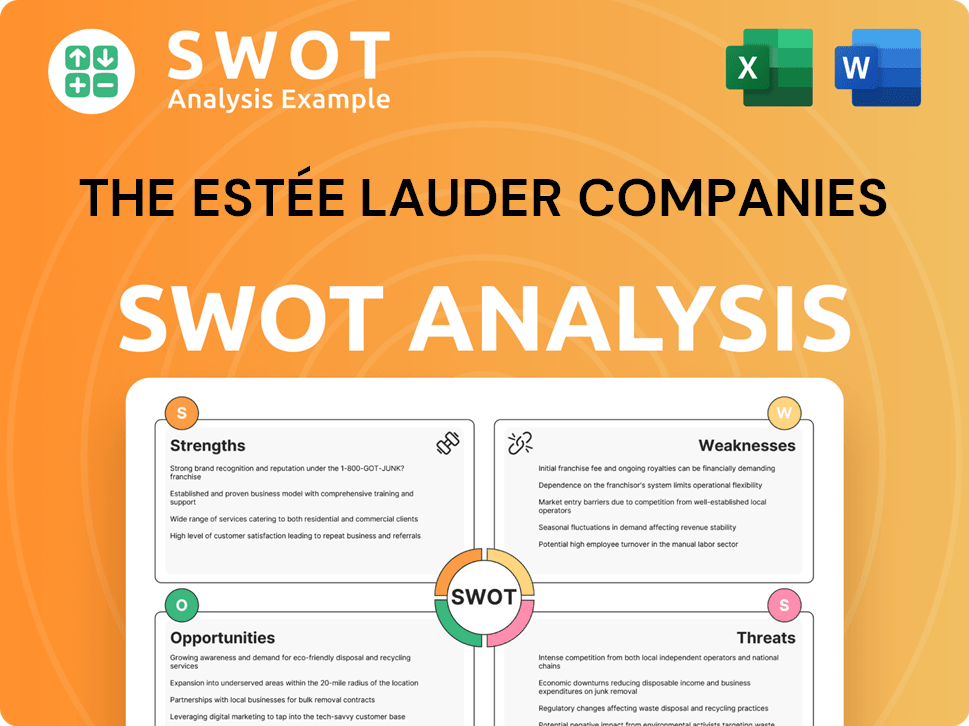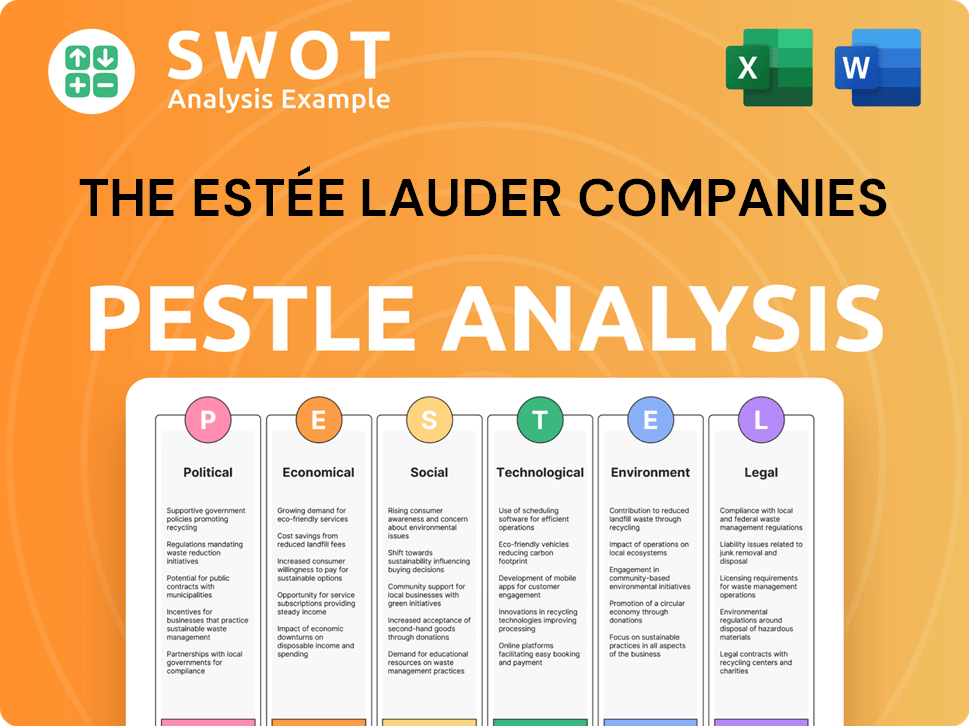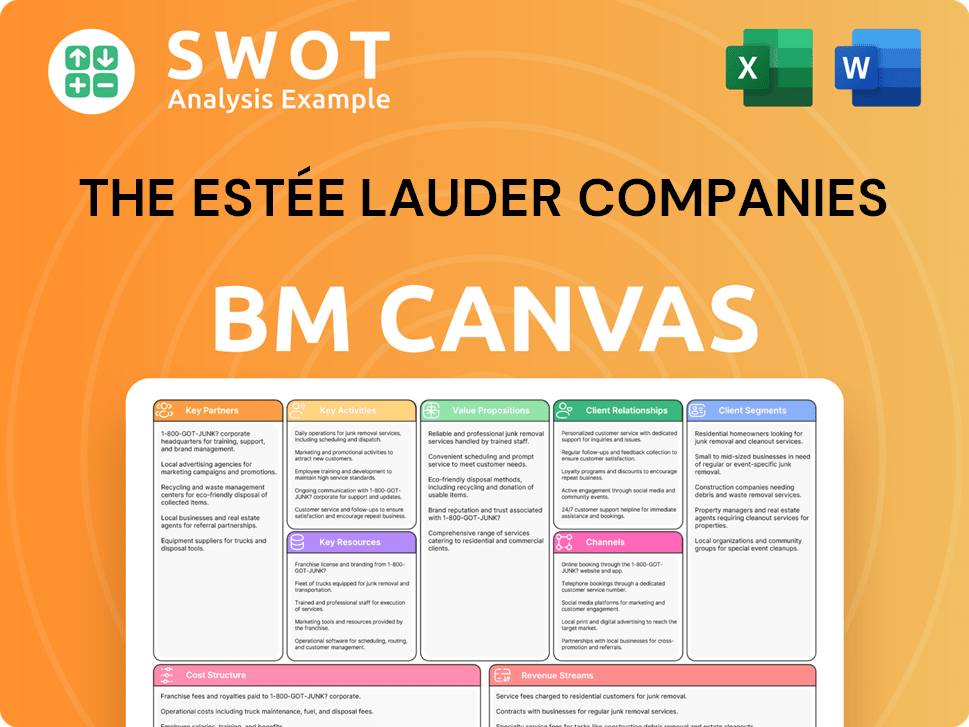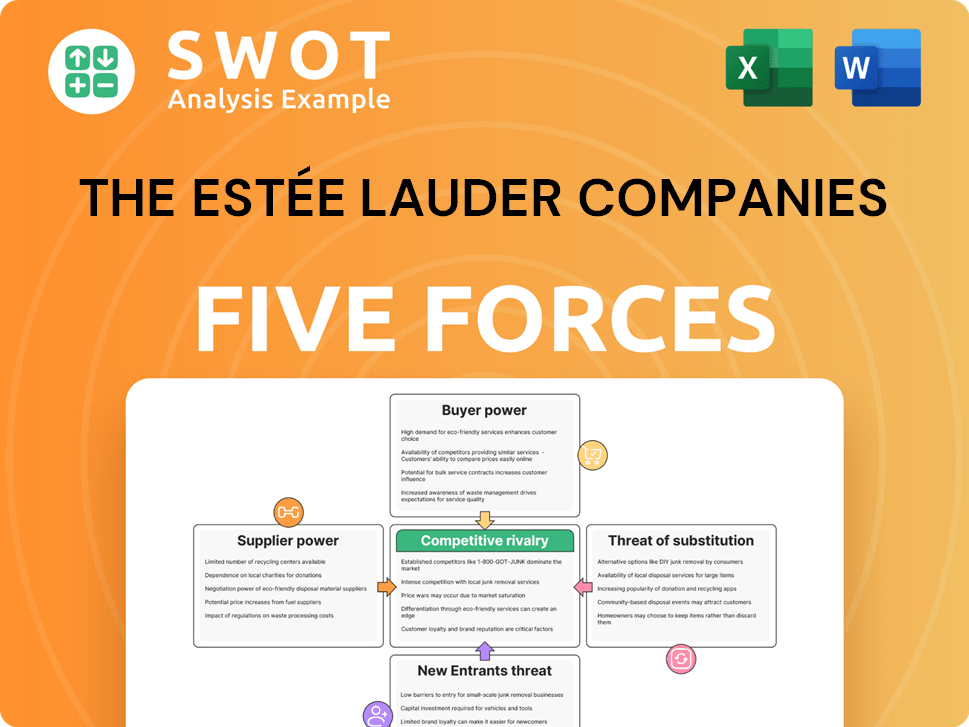The Estée Lauder Companies Bundle
How Did Estée Lauder Build a Beauty Empire?
From a small skincare line to a global cosmetics giant, The Estée Lauder Companies' journey is a testament to vision and innovation. Founded in 1946, the The Estée Lauder Companies SWOT Analysis reveals the strategic brilliance behind its enduring success. Explore the fascinating Estée Lauder history and discover how this ELC company transformed the cosmetics industry.

This article delves into the Estée Lauder company background, tracing its evolution from its founding of Estée Lauder to its current status. We'll examine key moments in the Estée Lauder's early years and its strategic moves, including Estée Lauder company acquisitions, that solidified its position among leading beauty brands. Understand the Estée Lauder's business strategy and its impact on the beauty industry.
What is the The Estée Lauder Companies Founding Story?
The story of The Estée Lauder Companies (ELC) begins in 1946, marking the official founding of the company by Estée Lauder and her husband, Joseph Lauder, in New York City. This marked the beginning of a journey that would transform the cosmetics industry.
Estée Lauder's passion for beauty was deeply rooted in her childhood. Her uncle, a chemist, introduced her to the world of skincare by formulating products in their kitchen. This early exposure provided Estée with the knowledge to create and apply skincare effectively, shaping her future path.
The initial business model was built on a direct, personal approach. Estée herself would demonstrate her products in beauty salons, offering a 'high-touch' service. This hands-on approach helped her connect with customers and build brand loyalty from the start.
The company launched with just four core skincare products, setting the foundation for its future success.
- Cleansing Oil
- Skin Lotion
- Super Rich All-purpose Creme
- Creme Pack
Estée Lauder's determination was evident early on. A notable anecdote recounts her bold move of breaking a perfume bottle in a department store that initially rejected her products. This daring act generated customer interest and ultimately led to an order, showcasing her innovative marketing approach.
The company's name, 'Estée Lauder,' has an interesting origin. Estée and Joseph, originally Joseph Lauter, adopted the surname Lauder in 1930 to correct a misspelling from when Joseph's father emigrated from Austria. This change solidified their brand identity.
The initial investment in the company was modest, with the Lauders starting with only $50,000. They strategically invested this amount entirely in samples rather than advertising. This strategy, which included the pioneering 'Gift with Purchase' concept, became an industry standard, driving sales and brand recognition. In 2024, ELC reported net sales of approximately $15.6 billion, demonstrating the long-term impact of their early strategies.
For more insights into the company's early years and its impact on the beauty industry, you can explore the Estée Lauder history.
The Estée Lauder Companies SWOT Analysis
- Complete SWOT Breakdown
- Fully Customizable
- Editable in Excel & Word
- Professional Formatting
- Investor-Ready Format

What Drove the Early Growth of The Estée Lauder Companies?
The early growth of The Estée Lauder Companies, or ELC company, was marked by strategic product introductions and market penetration. This period saw significant milestones, including securing a major department store account and launching a groundbreaking product. The company's expansion strategy focused on both domestic and international markets, laying the foundation for its future success. This rapid growth transformed the business into a global leader in the cosmetics industry.
In 1948, just two years after its founding, The Estée Lauder Companies secured its first major department store account with Saks Fifth Avenue in Manhattan. The initial order was valued at $800, which would be approximately $10,000 today. A pivotal product launch was 'Youth-Dew' in 1953, a bath oil that also served as a perfume. This product became a bestseller, changing the beauty landscape by making fragrance an everyday luxury. These early moves were critical to the Estée Lauder history.
The 1960s marked the beginning of The Estée Lauder Companies' international expansion. The company established its first international account with Harrods in London in 1960, followed by an office in Hong Kong in 1961. In 1964, Estée Lauder introduced Aramis, a men's fragrance and grooming line, which is still sold in 130 countries. This global focus helped to solidify the ELC company's position in the beauty brands market.
Further diversification occurred with the 1968 launch of Clinique, a dermatologist-guided cosmetic brand. Clinique later introduced 'Skin Supplies for Men' in 1976. The 1990s saw explosive growth through brand acquisitions and licensing agreements, transforming the company. This era included the creation of Origins in 1990 and fragrance licensing agreements with Tommy Hilfiger, Kiton, and Donna Karan. For more insight into the target market of The Estée Lauder Companies, check out this article: Target Market of The Estée Lauder Companies.
The company's growth strategy often involved competing with itself through new brands and distribution channels. This approach proved successful, even against initial skepticism from competitors. This strategic move helped in shaping The Estée Lauder Companies' company background. By continually expanding its brand portfolio and distribution networks, the company solidified its impact on the cosmetics industry, leading to its current status as a global leader. The company's early milestones set the stage for its future financial performance and marketing strategies.
The Estée Lauder Companies PESTLE Analysis
- Covers All 6 PESTLE Categories
- No Research Needed – Save Hours of Work
- Built by Experts, Trusted by Consultants
- Instant Download, Ready to Use
- 100% Editable, Fully Customizable

What are the key Milestones in The Estée Lauder Companies history?
The Estée Lauder Companies (ELC) has a rich Estée Lauder history, marked by strategic milestones and significant achievements in the cosmetics industry. From its humble beginnings to its current global presence, ELC has consistently adapted and innovated, shaping the landscape of beauty brands.
| Year | Milestone |
|---|---|
| 1946 | Estée and Joseph Lauder founded the company with four products and a belief in the power of touch. |
| 1953 | The launch of 'Youth-Dew' revolutionized the fragrance market, making perfume more accessible. |
| 1968 | Clinique, a dermatologist-developed brand, was introduced, focusing on allergy-tested and fragrance-free products. |
| 1990s-2023 | Strategic acquisitions, including MAC Cosmetics, Jo Malone London, La Mer, and Tom Ford Beauty, expanded the company's portfolio. |
| 2023 | The acquisition of Tom Ford Beauty for $2.8 billion further solidified its position in the luxury market. |
| 2025 | Stéphane de La Faverie became the new President and CEO on January 1, 2025. |
The company's innovations have been pivotal in the ELC company's success. A key innovation was the 'Gift with Purchase' concept, which became an industry standard. Another significant move was the introduction of Clinique, catering to diverse consumer needs with its allergy-tested cosmetics.
This marketing strategy, pioneered by Estée Lauder, offered customers complimentary gifts with their purchases, enhancing the perceived value of the products and driving sales. It became a standard practice across the beauty industry.
Launched in 1953, 'Youth-Dew' made fragrance more accessible by offering it as a bath oil, significantly expanding the market and making perfume a more everyday luxury.
Clinique, introduced in 1968, was a pioneering brand in the beauty industry. It focused on allergy-tested and fragrance-free cosmetics, addressing the needs of consumers with sensitive skin.
Over the years, Estée Lauder Companies expanded its portfolio through strategic acquisitions of prestigious brands. This broadened its market reach and appealed to different consumer segments.
The company has made significant strides in sustainability. They achieved several 2025 goals ahead of schedule in fiscal 2024, including a 23% reduction in water withdrawal from direct manufacturing sites.
Announced on February 4, 2025, this comprehensive restructuring plan aims to streamline operations, optimize the supply chain, and increase marketing effectiveness.
Despite its successes, ELC has faced significant challenges. Market downturns, particularly in China and Asia travel retail, have impacted sales. The company also reported a net loss in the first quarter of fiscal 2025, partially due to litigation settlements.
In the third quarter of fiscal 2025, net sales decreased by 10% to $3.6 billion, with organic sales dropping by 9%. Travel retail organic sales declined by 28% year-over-year.
The company reported a net loss of $156 million in the first quarter of fiscal 2025, partly due to $159 million in charges related to talcum litigation settlements.
The Asia travel retail market has faced significant headwinds, leading to sales declines. This is a crucial market for the company, and these challenges have had a notable impact.
As part of the 'Beauty Reimagined' restructuring, the company anticipates a net reduction of 5,800 to 7,000 positions globally by the end of fiscal year 2027, which is approximately 10% of its workforce.
The restructuring plan is projected to generate annual savings of $800 million to $1 billion, aiming to improve the company's financial performance and resilience.
Tom Ford Beauty has faced challenges with declining fragrance net sales in fiscal Q1 2025, impacting the brand's overall performance. This highlights the need for strategic adjustments.
To navigate these challenges, ELC has implemented strategic initiatives. The 'Beauty Reimagined' restructuring plan is designed to streamline operations and improve efficiency. For further insights into the company's strategies, you can explore the Marketing Strategy of The Estée Lauder Companies.
The Estée Lauder Companies Business Model Canvas
- Complete 9-Block Business Model Canvas
- Effortlessly Communicate Your Business Strategy
- Investor-Ready BMC Format
- 100% Editable and Customizable
- Clear and Structured Layout

What is the Timeline of Key Events for The Estée Lauder Companies?
The Estée Lauder Companies history reflects a journey of innovation and strategic growth in the cosmetics industry. From its humble beginnings in 1946 with just four skincare products, the company, now known as ELC, expanded rapidly, establishing itself as a leader in the beauty brands sector. Key milestones include securing its first major department store order in 1948, the launch of the groundbreaking fragrance 'Youth-Dew' in 1953, and international expansion starting in 1960. The company continued to innovate with the introduction of Aramis in 1964, Clinique in 1968, and Origins in 1990. ELC went public in 2000 and has continued to evolve, including partnerships with brands such as Tom Ford, and expanding its sustainability efforts, achieving Net Zero carbon emissions by 2020.
| Year | Key Event |
|---|---|
| 1946 | Estée and Joseph Lauder founded 'Estée Lauder cosmetics' in New York City, starting with four skincare products. |
| 1948 | Secured its first major department store order with Saks Fifth Avenue. |
| 1953 | Launched 'Youth-Dew,' a groundbreaking fragrance and bath oil. |
| 1960 | Began international expansion with an account in London's Harrods department store. |
| 1964 | Introduced Aramis, a pioneering men's fragrance and grooming line. |
| 1968 | Established Clinique, an allergy-tested, fragrance-free cosmetic brand. |
| 1981 | Products became available in the Soviet Union. |
| 1990 | Introduced Origins, the first wellness brand in U.S. department stores. |
| 1993 | Entered into its first fragrance licensing agreement with Tommy Hilfiger. |
| 2000 | The Estée Lauder Companies went public. |
| 2005 | Partnership with Tom Ford led to the creation of the Tom Ford Beauty brand. |
| 2020 | Achieved Net Zero carbon emissions and sourced 100% renewable energy for direct business operations. |
| 2023 | Acquired the Tom Ford brand. |
| January 2025 | Stéphane de La Faverie assumed the role of President and CEO. |
| February 2025 | Announced 'Beauty Reimagined' restructuring plan, including a reduction of 5,800 to 7,000 positions globally. |
| March 2025 | William P. Lauder stepped down as Executive Chairman but remains Chair of the Board. |
| March 31, 2025 | Reported fiscal 2025 third-quarter net sales decrease of 10% to $3.6 billion. |
The 'Beauty Reimagined' plan aims to restore sustainable sales growth and achieve a solid double-digit adjusted operating margin in the coming years. This involves streamlining operations and optimizing the supply chain. The company is focused on increasing marketing effectiveness and expanding its presence in high-growth channels and markets.
ELC aims to return to sales growth in fiscal 2026, assuming a meaningful resolution of tariffs. Despite the anticipated continued declines in the prestige beauty segment in China for fiscal 2025, ELC intends to drive share gains in this market. The company also plans to improve performance across developed and emerging markets.
Ongoing initiatives under the Profit Recovery and Growth Plan include further cost reductions, supply chain regionalization, and additional efficiency projects. ELC has made significant progress on its sustainability goals, with 71% of its packaging being recyclable, refillable, reusable, recycled, or recoverable in fiscal year 2024.
The company's forward-looking strategy emphasizes agility, innovation, and consumer-centricity. The goal is to reestablish its dominance in the evolving global beauty market. This will be achieved by focusing on the founding vision of making every woman beautiful.
The Estée Lauder Companies Porter's Five Forces Analysis
- Covers All 5 Competitive Forces in Detail
- Structured for Consultants, Students, and Founders
- 100% Editable in Microsoft Word & Excel
- Instant Digital Download – Use Immediately
- Compatible with Mac & PC – Fully Unlocked

Related Blogs
- What is Competitive Landscape of The Estée Lauder Companies Company?
- What is Growth Strategy and Future Prospects of The Estée Lauder Companies Company?
- How Does The Estée Lauder Companies Company Work?
- What is Sales and Marketing Strategy of The Estée Lauder Companies Company?
- What is Brief History of The Estée Lauder Companies Company?
- Who Owns The Estée Lauder Companies Company?
- What is Customer Demographics and Target Market of The Estée Lauder Companies Company?
Disclaimer
All information, articles, and product details provided on this website are for general informational and educational purposes only. We do not claim any ownership over, nor do we intend to infringe upon, any trademarks, copyrights, logos, brand names, or other intellectual property mentioned or depicted on this site. Such intellectual property remains the property of its respective owners, and any references here are made solely for identification or informational purposes, without implying any affiliation, endorsement, or partnership.
We make no representations or warranties, express or implied, regarding the accuracy, completeness, or suitability of any content or products presented. Nothing on this website should be construed as legal, tax, investment, financial, medical, or other professional advice. In addition, no part of this site—including articles or product references—constitutes a solicitation, recommendation, endorsement, advertisement, or offer to buy or sell any securities, franchises, or other financial instruments, particularly in jurisdictions where such activity would be unlawful.
All content is of a general nature and may not address the specific circumstances of any individual or entity. It is not a substitute for professional advice or services. Any actions you take based on the information provided here are strictly at your own risk. You accept full responsibility for any decisions or outcomes arising from your use of this website and agree to release us from any liability in connection with your use of, or reliance upon, the content or products found herein.